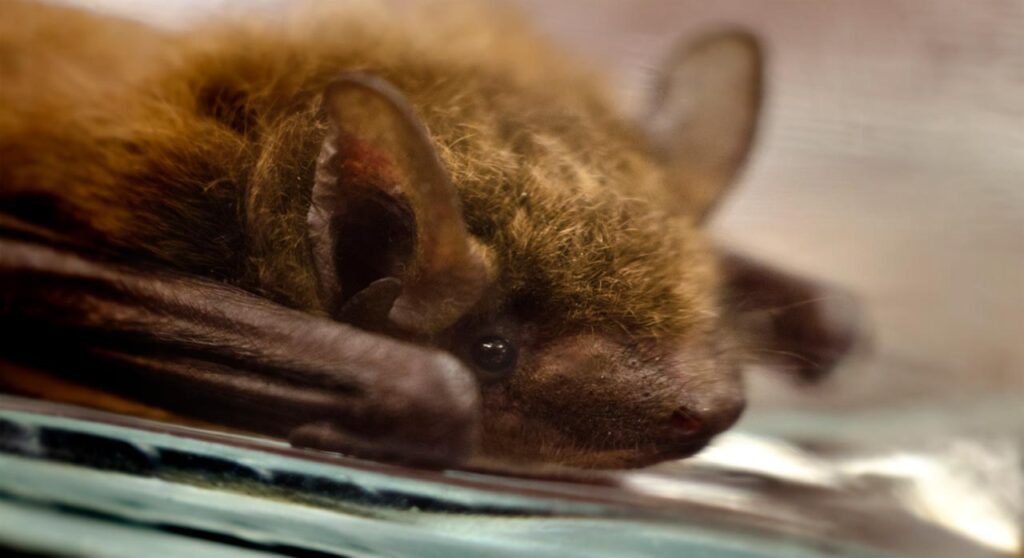Little Brown Bat Facts
Little brown bats are found all across North America. They are roughly three to four inches long with hairy, brown bodies and have about a nine-inch wingspan.

Little brown bats mate in the fall and have pups between late May and early July. The average lifespan for this species of bat is six to seven years. In some cases, however, little brown bats have been known to live for over 30 years.
Little brown bats are insectivores, so they only eat insects and especially favor mosquitoes. The little flying mammals are nocturnal and hunt for food at night. As is the case with most bats, little brown bats communicate using echolocation. They blast out a call and listen for an echo that bounces back to them off of their prey or other objects. Echolocation also helps them avoid other bats and obstructions while flying at night. Little brown bats can transmit diseases such as rabies, as well as parasites like tapeworms, fleas, and mites.
Little Brown Bat Bites
Although rare, little brown bats can carry and transmit rabies. This virus affects the central nervous system of mammals and is spread through saliva. A bat may have rabies if it is acting unnaturally, such as flying during the day or scrambling around on the ground.
If you believe you have been bitten or scratched by a bat and are experiencing flu-like symptoms, seek medical attention as soon as possible. Protect your family and pets from exposure to rabies by contacting a pest management professional to remove any nuisance wildlife in your home or on your property.
Little Brown Bat Infestation
Signs of a bat infestation might include strange noises like scratching and squeaking sounding from the walls or attic. Additionally, as bats enter and leave a structure, they’ll leave stains on the building’s siding from droppings and urine. These bat droppings, know as guano, will smell strongly of ammonia. Bats will enter and leave buildings or homes around dawn and dusk.
Bat infestations can lead to structural damage, health risks, and even the introduction of other pests. Piles of bat guano will eat away at the house, eventually ruining the structure’s insulation and sheetrock. Guano may also contain the spores of a fungus that can cause Histoplasmosis, an illness that affects the lungs.
Although rare, bats can carry the rabies virus. Little brown bats can also bring bat bugs, a cousin of the bed bug, into your home. Even though these bloodthirsty insects prefer bats as their hosts, bat bugs have no problem feeding off of humans too!
Types of Little Brown Bats
Little Brown Bat Identification
Little brown bats are named after their appearance. They are small and have glossy fur that can be dark brown, reddish, or golden brown in color. Their wings and membranes tend to be dark brown or black, and hairless. Little brown bat ears are tiny, but their hind feet are quite big.
Little Brown Bats in the House & Attic
These critters prefer warm, dry places like an attic or crawlspace. Little brown bats may also be found behind walls, in the garage or soffit, as well as under floorboards, shutters, and roof shingles. Due to its size, this little flying creature can find its way inside a structure through cracks and other openings.
We know you don’t want bats inside your home, but these mammals are important to our environment. A single little brown bat eats hundreds of insects every night including pesky bugs like mosquitoes. This is why Catseye Pest Control follows state regulations when removing them from a property.
From mid-April through the end of May, after bats are awake and feeding but before they start reproducing, Catseye will seal up the area where the bats are living and install an excluder. This funnel-shaped “door” allows bats to exit the building, but prevents them from getting back in. It is a safe way of making the bats leave your home to find a new place to live. Once all the bats have left, we remove the excluder and seal the opening.
In June, bats begin having babies. The pups remain in the roost and are dependent on their mothers for food. Catseye does not do exclusion work in June and July, as the pups aren’t strong enough to leave the roost. Catseye can resume bat-proof and exclusion services from August through October. By this time, the pups are able to fly and leave the nest.
Frequently Asked Questions
Do little brown bats bite?
Little brown bats will bite humans if they feel threatened, are provoked, or are sick. While these bats are not aggressive creatures, they are better left alone.
What do little brown bat bites look like?
Little brown bats have tiny, sharp teeth. Their bite marks are often mistaken for scratches, as they are tiny. Rarely does a little brown bat bite even break skin.
What are the benefits of professional little brown bat pest control?
A pest management professional has the educational background, equipment, and skills necessary to effectively address a little brown bat problem.
Finding and treating the little brown bats can be challenging, especially if they are spread throughout your yard.
A pest management professional can identify the pest problem and determine the most effective solution to remove a little brown bat infestation.
If your property is being infiltrated by little brown bats or other wildlife nuisances, contact us today. Our experienced pest control technicians can safely remove the pests from the premises.


